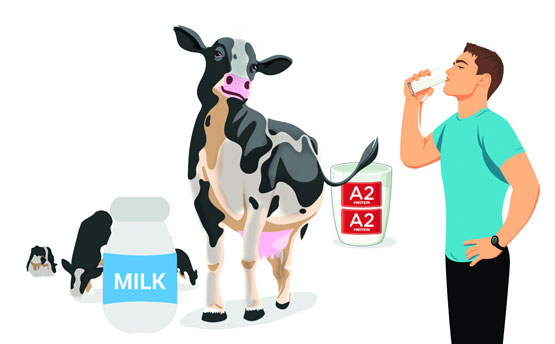Livestock capacity main challenge for milk sufficiency
Mahfuja Mukul: The contribution of the livestock sector to the agrarian economy of Bangladesh is significant. The livestock capacity of the country has increased with time. At the same time milk production has increased, milk production has increased almost four times in the last 12 years. However, balanced feed is one of the most important factors in increasing livestock performance.
Recently, as the issue of insufficiency of animal feed has come to the fore, the capacity of the livestock has been challenged, and at the same time, it may be hindered to achieve self-sufficiency in milk production.
Diet has an important influence on milk production and quality of cows. Feeding more food can produce more milk, but it must be a balanced diet.
Nutrients present in food are excreted in milk in different forms. Diet can increase or decrease the presence of butter in milk. Excessively grainy feed, pelleted feed, excessively juicy feed, finely ground hay can cause low buttermilk in cow’s milk. If the amount of butter is reduced, the diet should be changed and the necessary balanced diet should be fed. The amount of minerals and nutrients in milk can be increased by feeding the cow.
It is known that currently there is a demand of 250 ml of milk per capita per day. From 1971 to 1997 per capita availability of milk was 26 to 28 ml. In the financial year 2008-09, per capita availability of milk per day was 43.43 ml. At the end of the financial year 2021-22, the availability of milk increased to 208.61 million. Milk production increased from 22.86 lakh metric tons in 2008-09 financial year to 130.74 lakh metric tons at the end of 2021-22 financial year.
Former Director General of Bangladesh Livestock Research Institute (BLRI). Nathu Ram Sarkar told that achieving self-sufficiency in milk is not possible for livestock alone. Our farmers, gov
ernment should do this together. Government will need incentives, policy support will be needed. Self-sufficiency in milk production will be possible if livestock capacity is increased. Cattle plays a major role in milk production.
In that case, food supply is an important area. Health management, disease management, environmental management, waste management and marketing are major challenges in Bangladesh at the moment. Grass is a nutritious food for animals. The government is thinking about it, but it needs to be strengthened. The fodder that wakes up in different places can be used in this case. Artificial reproduction is now taking place. But it should be done systematically.
Many times farmers are seen giving Holstein Friesian to an animal. Later it was seen that Shahiwal gave it again. This is that breeding methods have improved a lot, but it needs to be done in a more systematic way. And technology can be feeding technology, housing technology, grass production technology, waste management technology.
Meanwhile, through the Livestock and Dairy Development Project (LDDP), initiatives have been taken to formulate and follow protocol-policies to ensure increased production and supply of milk in the country and establishment of 400 village milk collection centers in different parts of the country through private entrepreneurs. Out of this, 175 will be provided with cooling system. As a result, adequate supply of milk will be ensured at the consumer level. At the same time farmers can sell milk at a fair price.
Under this project, farmers will be trained to produce additional milk. Besides, through other activities, the aim of this project is to increase milk production in the country by 20 percent in five years.
Technology and Artificial Breeding to Increase Livestock Productivity
Most of the cows are indigenous and their milk production is negligible. However, whatever milk is available, they sell it in the market. Although a handful of cows give relatively high milk, they are also slowly losing milk production capacity due to lack of nutritious feed.
Those concerned say that technology is playing one of the roles in increasing the capacity of livestock. By using it, it is possible to play a role in the rapid diagnosis and control of diseases from the field level. Apart from this, it is necessary to give priority to various fields including animal maintenance, improved waste management, environmental management through the use of technology. In this the animal will be healthy on the one hand and milk production will also increase on the other hand.
Artificial insemination is usually done by collecting semen from a bull and placing it in the reproductive organs of a cow through certain methods. It is possible to breed 60 to 80 cows per year from the seed of a bull. But through artificial breeding, 5,000 to 10,000 cows can be bred. A bull can normally give birth to a total of 700 to 900 calves. Infectious diseases are largely prevented by artificial insemination and cows are not injured by bulls.
Officials of the Department of Livestock said that the neighboring country India is the first in milk production. They have some varieties of their own. 60-70 percent of India’s milk comes from buffaloes. But we don’t have a good breed of our own. There are varieties that are not globally acceptable. As a result, they are not able to play a role as they are not world class. If you don’t have a good breed of cow, you won’t get much milk. In 1973 artificial insemination program started in the country.
Rare Israeli airstrike in Beirut kills Hezbollah commander and more than a dozen others
International Desk: Israel launched a rare airstrike that killed a senior Hezbollah milita…








